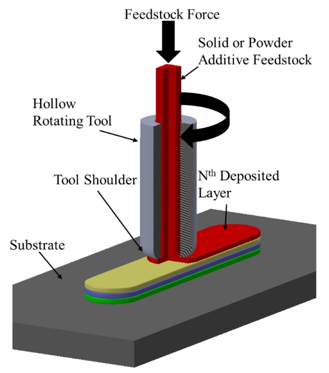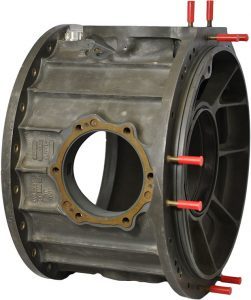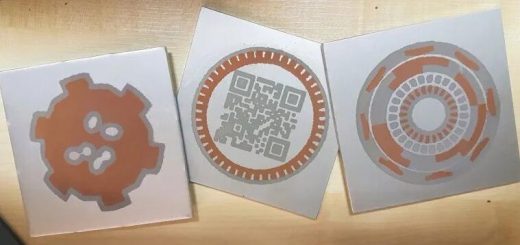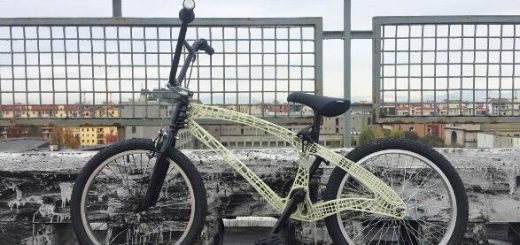MELD Introduces Solid-State 3D Printing System
MELD Manufacturing has commercialized a metal production process that promises to enable 3D printing to carve out a greater role in the manufacturing sector.
MELD’s B8 printer applies a solid-state thermomechanical additive manufacturing process called additive friction stir (AFS). AFS uses friction-generated heat to deposit metal feedstock onto the substrate at a high-deposition rate without reaching the melting temperature. In this process, the system forces filler material through the hollow AFS tool, and then stirs the filler material into the substrate. The process yields a metallurgical bond between additive and substrate with a refined grain structure. AFS deposits are fully dense and do not require a secondary densification process. (Image courtesy of MELD Manufacturing.)

MELD’s B8 printer “stirs” layers together without high heat. Image courtesy of MELD Manufacturing.
Until recently, manufacturers’ efforts to apply 3D printing in large-scale production areas have been thwarted by inherent limitations of the technology. Traditional metal printing processes can suffer from spatially restrictive deposition chambers, slow production rates, and undesirable physical properties. MELD’s technology boasts capabilities that could well sweep aside these barriers, enabling additive manufacturing (AM) to make greater inroads in the industrial sector.
![]() How It Works
How It Works
At the core of MELD’s system, you find the B8 printer, which resembles a multi-axis CNC machine more than a traditional laser sintering additive manufacturing system.
MELD technology’s greatest break with traditional AM practices is its reliance on a solid-state approach. MELD’s B8 printer applies a thermomechanical additive manufacturing (AM) process similar to friction stir additive manufacturing (FSAM). Rather than fuse existing layers of material as in the FSAM process, MELD uses friction-generated heat to deposit new metal feedstock at a high-deposition rate without reaching a melting temperature. In the MELD process, the system forces material through a hollow, roatating tool, stirring the material into the material beneath it. The company says the process yields a metallurgical bond between layers with a refined grain structure. The stirring action breaks up individual material grains into smaller sizes, which provides enhanced strength and performance properties, including corrosion and wear resistance, according to the company. MELD deposits are said to be fully dense and do not require a secondary densification process.
By operating at lower temperatures, MELD’s technology is said to avoid material flaws like porosity and hot cracking. The company says this enables the 3D printer not only to produce high-quality parts, with full density, but also to consume less energy than melt-based processes. It also allows the MELD B8 to have an “open atmosphere” that the company says opens up a new range of applications for its 36x12x12-in. build volume.
“For coatings, repairs, or addition of features, we fixture the base part onto the table, and then add or build material on it,” says Nanci Hardwick, CEO of MELD Manufacturing. “Melt-based processes generally have a very weak bond between the deposited material and what it is deposited onto. MELD is different in that the first layer of deposited material is stirred into the substrate. Every subsequent layer is stirred into the previous layer. The resulting metallurgical bond is very strong. This is part of what gives melded parts wrought properties. It is what creates a bond that will not delaminate or crack in coatings. It is what makes repair robust.”

The B8 MELD machine offers the flexibility of open atmosphere operation, mitigating health and safety concerns. In addition, the printer reduces operating costs with low-power operation. Typical power consumption falls between 10 A and 20 A. (Image courtesy of MELD Manufacturing.)
Operating software controls processing parameters, including spindle speed, filler feed rate, and traverse rate. Build instructions are in machine g-code, so machinists who use mills and lathes can operate a MELD machine with minimal training.
The entire production operation occurs in ambient conditions, making the machine less complex and less expense to operate. Because built parts are already fully dense, there is no need for the post-processing finishing steps required by melt-based systems, according to the company. Fewer steps ultimately save time and money.
![]() Printing Materials
Printing Materials
MELD printers support two types of material feed systems. They can bond powder metals or combinations of different powders to either alloy in situ or make metal matrix composites (MMCs). The printers can also bond solid metals. Regardless of what form of feedstock you use, the forces in play are the same, the equipment is the same, and the outcome is the same. “When watching the production of a melded part, you cannot tell whether powder or solid metal was used because the deposition looks the same,” says Hardwick.
The use of solid feedstock is unique in additive manufacturing for metals and has several benefits. The feedstock is generally less expensive because it does not have to go through the extra processes of being ground or atomized. Operation and storage is safer because metal powders have a risk of fire or explosion. It is also safer for operators, who are at risk of breathing in the powders.
To date, MELD has been used to deposit light metals, such as aluminum and magnesium; and high-temperature metals, such as inconel and oxide-dispersion-strengthened steels. In addition, the technology can process unweldable materials and powders that cannot be used in melt-based additive processes. MELD technology has also been used with reactive materials like titanium. Users have combined different combinations of materials to create MMCs; functionally graded, multi-material parts; and bi-metallics.

Currently, MELD can form magnesium, aluminum, aluminum silicon carbide, copper, copper metal matrix composites, magnesium, steel, strengthened steel, and ultra high strength steel. As a result, its solid-state process can 3D print proven and previously “unweldable materials,” such as the magnesium gear housing box shown here. (Image courtesy of MELD Manufacturing.)
Currently, MELD can form magnesium, aluminum, aluminum silicon carbide, copper, copper metal matrix composites, magnesium, steel, strengthened steel, and ultra high strength steel. A magnesium gear housing box is shown here. Image courtesy of MELD Manufacturing.
MELD systems support a range of applications, including printing metal features onto existing applications as a secondary process; repairing, coating, and joining the same or dissimilar materials; and production of large metal components.
Most melt-based techniques require powders, either in a bed arrangement or actively fed via a powder feeder. Typically, a heat source (e.g. a laser) is used to fuse the material and create a part. MELD says these techniques suffer from challenges in achieving full density, an inability to perform grain refinement (e.g. nanostructured materials), and potential safety problems with flammable powders.
MELD contends that it addresses these issues with technology that offers a combination of size, speed, flexibility, and quality at lower acquisition and operating costs.
In terms of scale, the MELD process promises to enable manufacturers to print large metal parts at a scale that stands out in the metal additive market. The key enabler of this leap in scalability is that MELD is not encumbered by powder bed-, atmospheric chamber-, or vacuum system constraints.
![]() 3D Science Valley Review
3D Science Valley Review
Though the article has used powder bed 3d printing technology to be compared wtih MELD’s AFS additive manufacturing technology, but we think this two technology are not compete with each other on the same level. For very complex structure, powder bed 3d printing technology has unique advantage.
Resource:RapidReady




Recent Comments